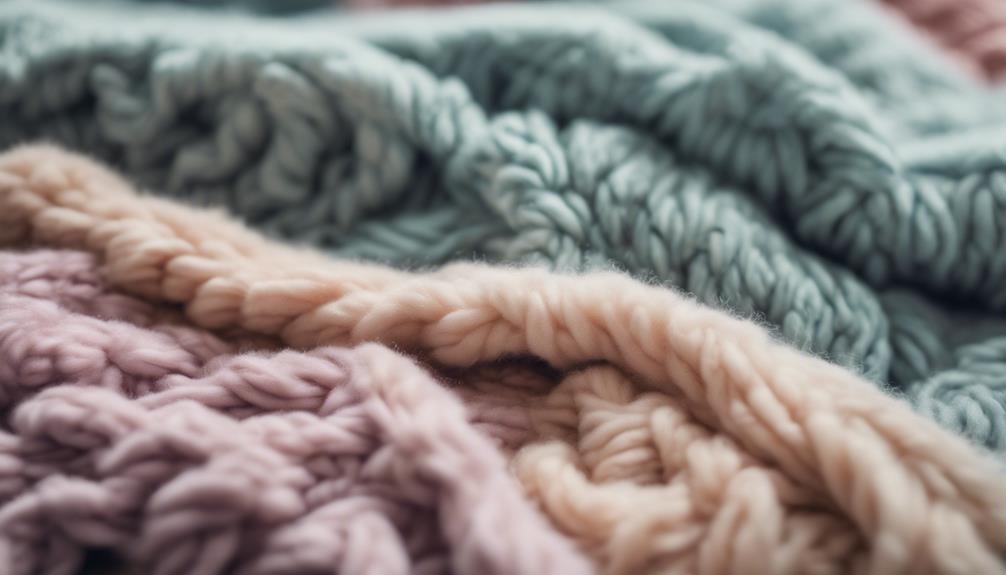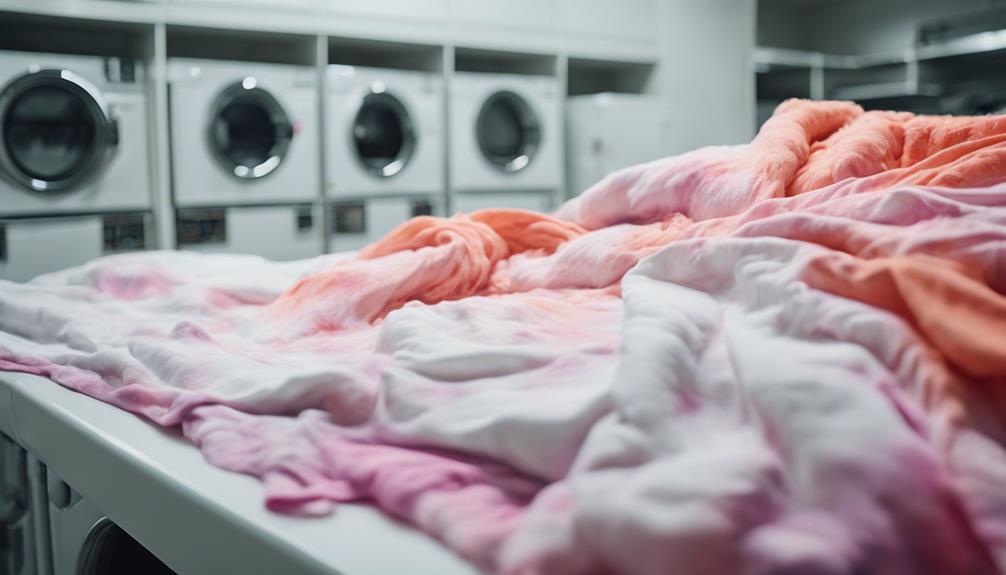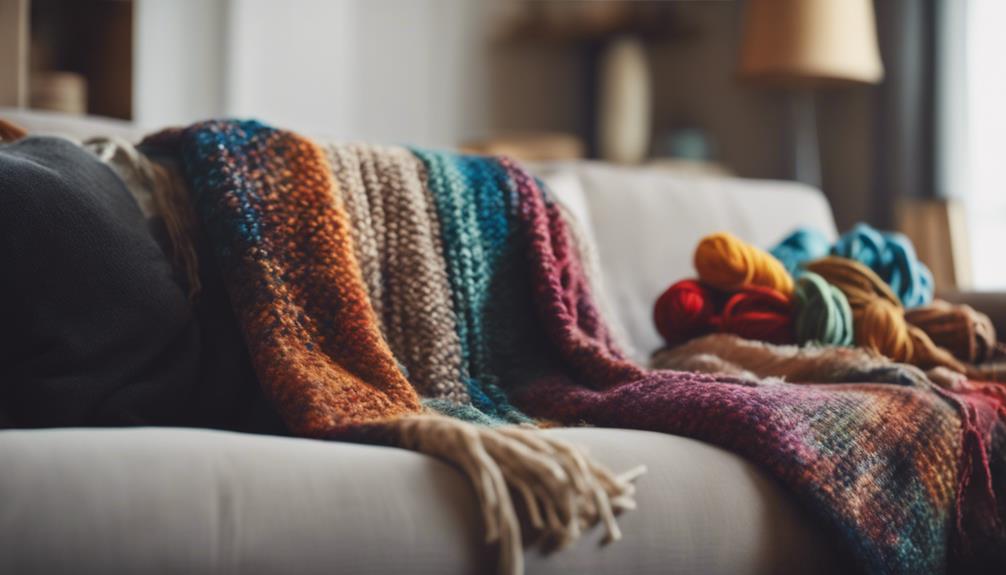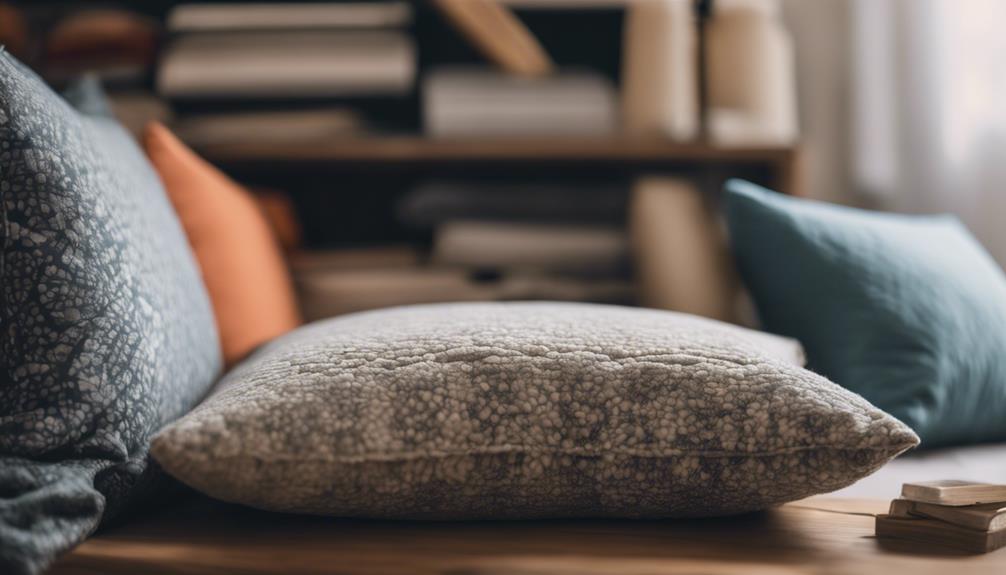When making a blanket, whether for a throw or queen size bed, it is important to consider the amount of yarn needed. Typically, you will require 800-1000 yards of chunky yarn for a throw blanket, with larger throws possibly needing up to 1200 yards. For a queen size blanket, the yardage can range from 1800-2500 yards. The amount of yarn needed can vary depending on the stitch pattern and tension used. Denser stitches will require more yarn, while lacy patterns will use less. It is essential to take into account the stitch densities and yarn weight when estimating how much yarn to purchase. Following the manufacturers’ guidelines can also help in accurately calculating the required amount of yarn. To avoid running out of yarn during the crafting process, it is recommended to acquire a bit more than estimated. This precaution can help ensure successful projects.
Key Takeaways
- Throw blankets need 800-1000 yards of chunky yarn.
- Larger blankets may require up to 1200 yards.
- Queen size blankets typically need 1800-2500 yards.
- Consider stitch patterns, density, and yarn weight for accurate estimation.
- Purchase slightly more yarn to prevent shortages in crochet projects.
Yarn Yardage for Throw Blanket
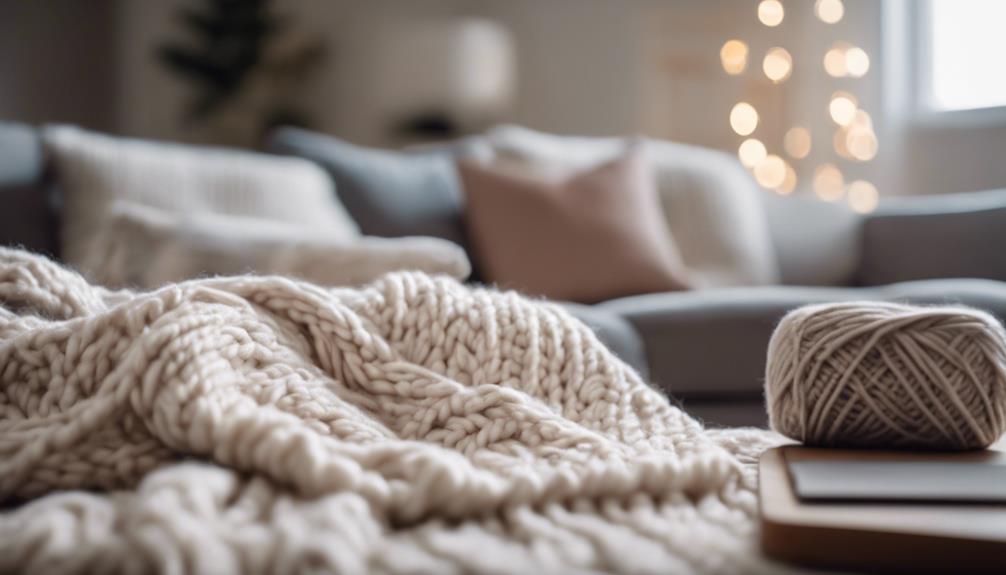
When crocheting a throw blanket, we typically require around 800-1000 yards of chunky yarn to achieve a cozy and inviting finish. Chunky yarn is excellent for creating a warm and snuggly blanket due to its thickness and plush texture.
It's important to select a chunky yarn with a yardage of 30-45 yards per skein to guarantee we've enough for the project. Some larger throw blankets may need up to 1200 yards of chunky yarn for a denser feel.
By choosing a quality chunky yarn with good yardage, we can accurately estimate the total amount needed for our crochet project. It's also advisable to purchase slightly more yarn than calculated to account for any variations in tension or modifications to the pattern.
This approach helps prevent running out of yarn before completing the blanket and ensures a consistent look and feel throughout the project.
Yarn Yardage for Queen Size Blanket

To achieve a cozy and inviting finish for a queen size blanket, we typically require approximately 1800-2500 yards of chunky yarn, depending on the stitch pattern and tension utilized. When working on a project of this size, having sufficient yarn is crucial to avoid interruptions. Here's a rough estimate of the yardage needed for a queen size blanket:
| Queen Size Blanket | Yardage Range |
|---|---|
| Minimum Estimate | 1800 yards |
| Average Recommendation | 2150 yards |
| Generous Amount | 2500 yards |
| Maximum Estimate | Varies |
Considerations for Stitch Patterns
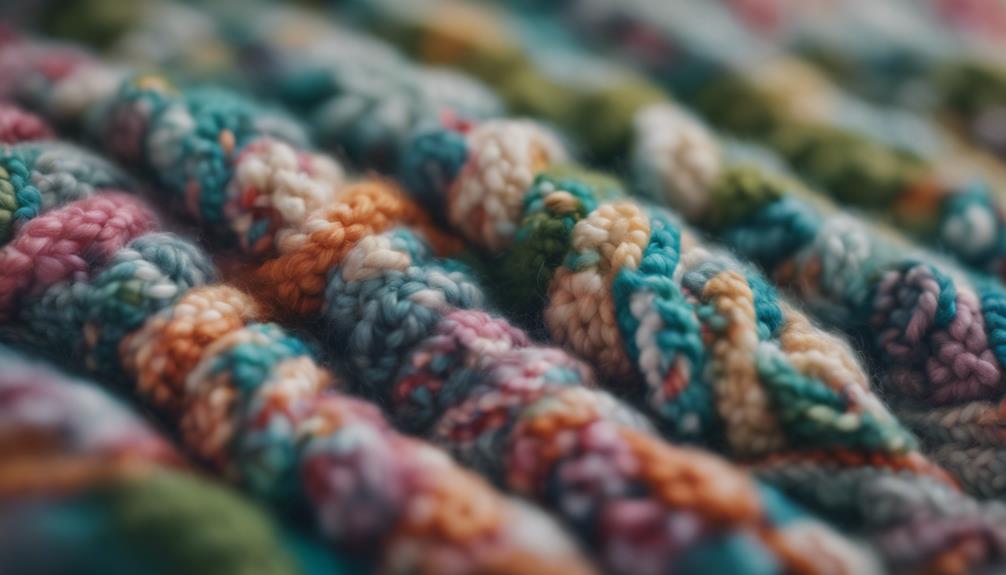
Taking the stitch patterns into account is essential when determining the amount of chunky yarn needed for a crochet blanket project. Different stitch patterns can have a substantial impact on the amount of yarn needed due to their varying densities and textures. Here are some key considerations to keep in mind:
- Yarn Weights: The thickness of the yarn used in a specific stitch pattern can affect the overall yardage required. Chunky yarn will cover more surface area compared to finer yarn weights, potentially altering the total amount needed.
- Stitch Pattern: Dense stitch patterns like moss stitch or basketweave will consume more yarn as they create a solid fabric. On the other hand, lacy or open stitch patterns will use less yarn due to their airy nature, requiring less yardage to complete the blanket.
- Amount of Yarn Needed: Textured stitch patterns such as cables or bobbles may necessitate extra yarn due to their 3D structures, increasing the overall yardage required for the project. Consider the stitch pattern carefully to estimate the appropriate amount of chunky yarn needed accurately.
Impact of Stitch Density on Yardage
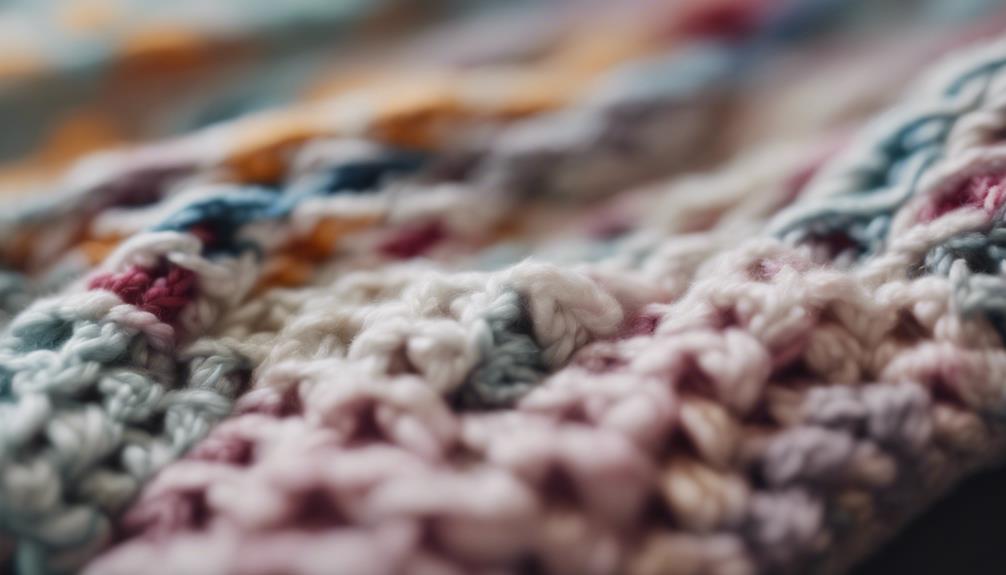
Taking into account the influence of stitch density on yardage is essential when planning for a crochet blanket project using chunky yarn. The density of your crochet stitches directly impacts how much yarn you will need for your blanket. Dense stitches, like single crochets or moss stitches, use more chunky yarn per yard as they create a tighter structure. On the other hand, holey stitches such as lace or mesh patterns use less yarn per yard due to their open spaces. Additionally, 3D stitches like bobbles or popcorn stitches consume yarn faster than flat stitches because of their dimensional nature. Variegated or multi-color chunky yarn can also affect your yardage estimation, as color changes impact yarn usage. Lastly, your tension while crocheting with chunky yarn plays a significant role in determining the amount of yarn needed for your blanket.
| Stitch Density | Impact on Yarn Usage |
|---|---|
| Dense Stitches | More Yarn |
| Holey Stitches | Less Yarn |
| 3D Stitches | Faster Yarn Consumption |
| Variegated Yarn | Color Changes Affect Usage |
| Tension | Significant Yarn Amount Variation |
Guidelines From Yarn Manufacturer

Yarn manufacturers provide valuable insights on yarn labels, guiding us on the appropriate amount of chunky yarn required for different blanket sizes. By following these recommendations, we can easily estimate the yardage needed for our crochet projects.
It's crucial to consider these guidelines to guarantee we've sufficient yarn for our desired blanket size.
Yarn Quantity Recommendations
In determining the amount of chunky yarn needed for a crochet blanket, it's beneficial to refer to the yarn manufacturer's guidelines for recommended quantities. When it comes to estimating yarn quantity, especially for chunky yarn blankets, these guidelines can be quite helpful. Here are some points to take into account:
- Check the yarn label for specific yardage information on the skeins.
- Some chunky yarn brands offer blanket patterns with pre-calculated yarn quantities for various blanket sizes.
- It's wise to factor in stitch density, blanket size, and your personal tension while calculating the amount of chunky yarn required.
Considerations for Blanket Size
To determine the appropriate amount of chunky yarn needed for your crochet blanket, consider the guidelines provided by the yarn manufacturer for different blanket sizes. Different blanket sizes require varying amounts of yarn to make sure you have enough to complete your project.
For instance, using Bernat Blanket Big Yarn, you'd need 6 balls for a 48 x 60-inch blanket, 5 balls for a 40 x 60-inch blanket, and 8 balls for a 50 x 70-inch blanket. If you're planning a larger project, such as a 60 x 70-inch blanket, you may require 10 balls of yarn. For even bigger blankets, like a 60 x 80-inch one, the manufacturer recommends using 12 balls of yarn.
Factors Affecting Yardage Needs

Considering various factors like the choice of crochet stitch, tension while crocheting, color changes, and yarn weight greatly influences the yardage needs for a crochet blanket. These aspects play an important role in determining how much chunky yarn you'll require for your project.
Here are three key points to keep in mind:
- Yarn Weight: Different yarn weights impact the amount of yarn needed, with super bulky yarn requiring less yardage compared to lighter weight options.
- Crochet Stitch: The type of crochet stitch used can greatly affect the yardage requirements, as denser stitches typically consume more yarn than more open, lacy stitches.
- Tension: Your tension while crocheting, whether tight or loose, influences the overall yarn quantity used. Tighter tension generally results in higher yarn consumption, while looser tension may require less yarn.
Determining Yardage for Specific Projects

Taking into account the factors mentioned earlier, determining the yardage needed for specific crochet projects is essential for proper planning and successful completion. When working with chunky yarn, factors such as blanket size, crocheting tension, and stitch pattern play a significant role in estimating the required yardage.
For instance, a baby blanket typically requires around 700-900 yards of chunky yarn, while a throw may need 1500-2000 yards. Larger blankets could demand 2500-3000 yards. Please be aware that the exact yardage can vary depending on these factors. Chunky yarn skeins also differ in yardage, so always check the label for accurate information.
To avoid running out of yarn mid-project, consider purchasing slightly more than estimated. Additionally, utilizing online calculators can assist in determining the precise amount of chunky yarn needed for your specific project requirements.
Yardage Calculation for Different Sizes

When determining the amount of chunky yarn needed for a crochet blanket, it's important to take into account the blanket size and the corresponding yardage required.
Blanket size options and the yarn amount guide play a significant role in calculating the appropriate yardage for a successful project.
Blanket Size Options
Determining the yardage needed for different blanket sizes of chunky yarn is essential for planning your crochet project accurately. When selecting the size of your blanket, consider the following options:
- Small baby blanket (30×30 inches): Approximately 600-900 yards of chunky yarn may be required.
- Throw blanket (50×60 inches): Around 1500-1800 yards of chunky yarn could provide a cozy finish.
- Twin size blanket (66×90 inches): For full coverage, you might need 3000-3600 yards of chunky yarn.
These variations in size will dictate the amount of yarn needed to craft a blanket that matches your desired dimensions.
Yarn Amount Guide
To accurately determine the yardage needed for different blanket sizes using chunky yarn, consider the dimensions of your project and the corresponding yarn requirements. For a small throw, you may need approximately 800-1500 yards of chunky yarn, while larger blankets could require 2000-3000 yards. It's crucial to factor in the desired size and stitch pattern to estimate the exact yardage needed accurately. Chunky yarn typically comes in skeins of 100-200 yards, so make sure to calculate accordingly. Remember, it's advisable to purchase slightly more yarn than your estimate to avoid the risk of running out mid-project. Below is a helpful guide to estimate the yardage needed for different blanket sizes:
| Blanket Size | Yardage Range |
|---|---|
| Small Throw | 800-1500 yards |
| Medium Blanket | 1500-2000 yards |
| Large Blanket | 2000-3000 yards |
| Twin Size | 3000-4000 yards |
| Queen/King Size | 5000+ yards |
Avoiding Excess or Insufficient Yarn
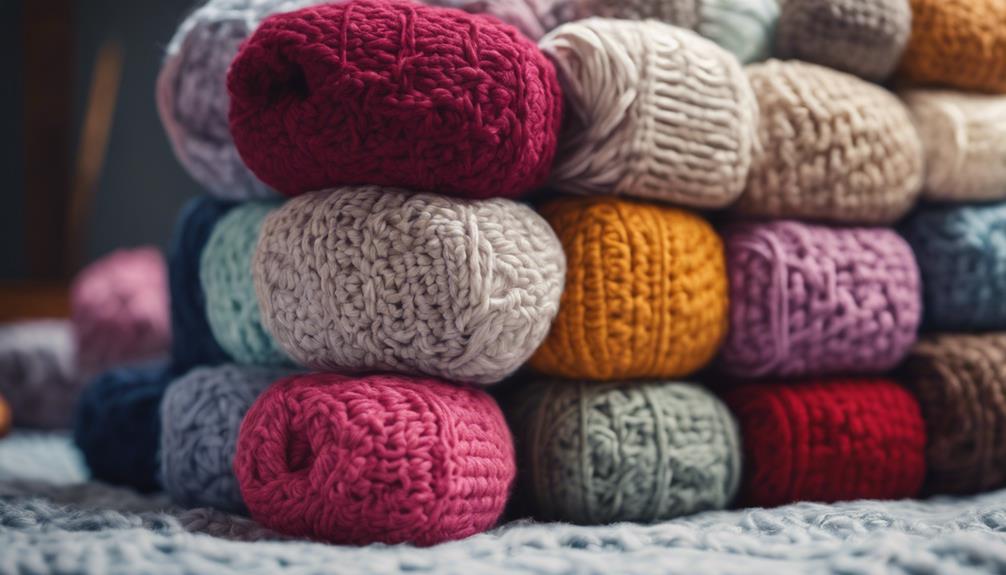
To guarantee we've the right amount of chunky yarn for a crochet blanket involves careful calculation and a consideration for potential extra yarn needs. When estimating how much yarn is needed for a crochet project, it's crucial to take into account various factors such as the size of the blanket, the type of stitch used, and the tension applied.
To avoid running out of yarn, it's advisable to calculate the total yarn required based on these factors and add a buffer to prevent shortages. Here are some tips to help you manage your yarn effectively:
- Consider buying slightly more yarn than the estimated amount to prevent running short during the project.
- Keep track of the yarn used and leftover yarn to improve accuracy in estimating future projects.
- Plan for borders, embellishments, and color changes to ensure you have enough yarn for the entire blanket.
Frequently Asked Questions
How Much Yarn for a Chunky Crochet Blanket?
When crocheting a chunky blanket, determining the amount of yarn needed is crucial. Factors like blanket size, stitch type, and tension influence yardage requirements. Chunky yarn demands more per ounce due to its thickness.
Consider color changes, stitch density, and personal style. Use online tools, yarn labels, and track usage for accurate estimates. Understanding these factors guarantees sufficient yarn supply for your chunky crochet project.
How Much Super Chunky Yarn Do I Need for a Blanket?
When tackling the task of calculating the yarn needed for a blanket, consider the size and stitch pattern.
For super chunky yarn, a small lap blanket may require 100-200 yards, while a medium throw could use 400-800 yards.
Larger blankets like queen or king sizes might need 1200-2000 yards.
The yardage can vary based on the yarn's thickness, with super chunky yarn generally having 5-20 yards per ounce.
How Many Feet of Yarn Do I Need for a Chunky Blanket?
When crocheting a chunky blanket, determining the required yarn length can be essential. The question 'how many feet of yarn do I need for a chunky blanket?' is common among crafters.
To calculate this, we consider the blanket's size, stitch pattern, and yarn thickness. Generally, chunky blankets often need 100-150 yards per pound of yarn. For a 50' x 60' blanket, around 6-9 pounds might be necessary.
How Many Skeins of Bernat Blanket Yarn to Make a Blanket?
When making a blanket using Bernat Blanket Yarn, the number of skeins required varies depending on the blanket's size and stitch density. For instance, a 30×40 inch baby blanket may need 3-4 skeins, while a larger 50×60 inch throw blanket could require 6-7 skeins.
Each skein contains about 220 yards of yarn. It's wise to buy extra skeins for tension variations or adding a border.
What Is the Difference Between Chunky Yarn and Super Bulky Yarn for Crocheting a Blanket?
Chunky yarn and super bulky yarn for blanket are both great options for crocheting a blanket, but they do have some differences. Super bulky yarn for blanket is thicker and will work up faster, creating a chunkier and warmer blanket. Chunky yarn is slightly thinner and will result in a lighter, airier blanket.
Conclusion
To summarize, calculating the yardage needed for crocheting a blanket is essential to avoid running out of yarn or having excess leftovers.
By considering factors such as blanket size, stitch pattern, and stitch density, you can determine the right amount of chunky yarn required for your project.
So next time you start on a crochet blanket endeavor, remember to plan ahead and calculate your yardage accurately for a successful outcome.



